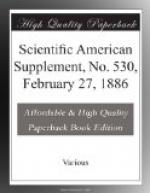Alizarine, which has been extensively discussed in various articles in our journal, is the coloring matter contained in the madder root. In 1869, two German chemists, Graebe and Liebermann, succeeded in artificially producing this dyestuff from anthracene, a component of coal-tar. The artificial dyestuff being perfectly pure and free from those contaminations which render the use of madder difficult, it soon was preferred to the latter, which it has at present nearly completely displaced.
The discovery of alizarine red was soon followed by those of alizarine orange, galleine, coeruleine, and, in 1878, of alizarine blue.
The slow adoption of these dyestuffs in the wool-dyeing industry is principally attributable to the deep-rooted distrust of wool dyers against any innovation. This resistance, however, is speedily disappearing, as every manufacturer and dyer trying the new dyestuffs invariably finds that they are in no respect inferior to his fastest dyes produced with indigo and madder, but are simpler to apply and more advantageous for wool.
The alizarine colors are dyed after an old method which is known to every wool dyer. The wool is first boiled for 11/2 hours with chromate of potash and tartar, then dyed upon a fresh bath by 21/2 to 3 hours’ boiling. All alizarine colors (such as those of the Badische Anilin und Soda Fabrik, of Ludwigshafen and Stuttgart; Wm. Pickhardt & Kuttroff, New York, Boston, and Philadelphia, viz.):
Alizarine orange W, for brown
orange,
Alizarine red WR, for yellow
touch ponceau or scarlet,
Alizarine red WB, for blue
touch yellow or scarlet,
Alizarine blue WX and SW,
for bright blue,
Alizarine blue WR SRW, for
dark reddish blue,
Coeruleine W and SW, for green,
and
Galleine W, for dahlia,
are dyed after the same method, which offers the great advantage that all these colors can be dyed upon one bath, and that by their mixture numerous fast colors can be produced. On the ground of numerous careful experiments, the writer recommends the following method, which gives well developed and well fixed colors, viz.:
For 100 kil.—The scoured and washed wool is mordanted by boiling for 11/2 hours in a bath containing 3 kil. chromate of potash and 21/2 kil. tartar, and lightly rinsed; when it can immediately be dyed. For 1,000 lit. water, 1 lit. acetic acid of about 7 deg. Be. is added to the bath. If the water is very hard, double the quantity of acetic acid, which is indispensable, is added. Then the required quantity of dyestuff is added, well stirred, the wool entered, and the temperature raised to boiling, which is continued for 21/2 to 3 hours, that is, until a sample taken does no longer surrender any color to a hot solution of soap. Loose wool and worsted slubbing can be entered at 60 deg. C. (140 deg. F.). In dyeing yarn and piece-goods, however, it is advisable to enter the bath cold, work for about




